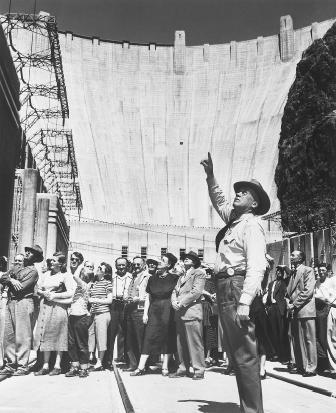Hoover Dam
In 1928, the U.S. Congress authorized the Boulder Canyon Project, later known as Hoover Dam. The project's success helped usher several decades of major water projects funded by the U.S. government.
Hoover Dam is located on the border between Arizona and Nevada. It is within Black Canyon on the Colorado River, near Las Vegas. The construction of Hoover Dam began in 1931. When completed in 1936, the dam was a major engineering achievement at a height of 221 meters (726 feet) and crest-width of 379 meters (1,244 feet).
The reservoir that formed behind the dam is Lake Mead, one of the world's largest artificially created bodies of water. It covers an area of 603 square kilometers (233 square miles), and its shoreline measures 885 kilometers (550 miles). The hydroelectric generators of Hoover Dam—capable of supplying nearly 1.5 million kilowatts of power—provide electricity to Arizona, southern California, and Nevada.
Construction and Benefits
Before the construction could start, the Colorado River had to be diverted through tunnels. These tunnels would allow the water to bypass the site of the dam foundation, and later would contain the electric plant generators. Building tunnels directly through the canyon rock walls required huge amounts of dynamite in order to remove rock, and enormous support structures to maintain the passageways. Once the first two tunnels where in place, cofferdams were built to divert the Colorado River. This accomplishment signaled that the actual dam construction could begin.
Base Surface.
Because of its importance in the overall integrity of the dam, the foundation was a major factor in building a structure that would be assured not to fail. This necessitated the removal of the mud and muck at the river bottom. Workers with the assistance of power shovels excavated over 382,300 cubic meters (500,000 cubic yards) of these deposits in order to

Pouring Concrete.
On June 6, 1933, the pouring of concrete began at the dam's base. Two-hundred-thirty blocks of concrete, totaling a volume of 2.49 million cubic meters (3.25 million cubic yards), were used to complete the base on May 29, 1935. This pouring process was necessary to allow the concrete to properly dry. It was stated that enough concrete was used to pave a 4.9-meter (16-foot) wide highway from San Francisco to New York City. The filling of Lake Mead now began.
Why Build?
The main reason for building Hoover Dam was to supply the electrical power necessary to transport 4.4 million acre-feet—over a quarter of the Colorado River's average annual flow—to California. Soon, the dam also would supply water to Las Vegas, whose revenue would be used to finance more water projects. Hoover Dam also allowed waterworks along the lower Colorado to be safely constructed and maintained as they operated upstream on a (now) tamely flowing river.
Benefits and Impacts.
Because of Hoover Dam, the Colorado River was controlled for the first time in history. Farmers received a dependable supply of water in Nevada, Arizona, and California. Numerous cities such as Los Angeles, San Diego, and Phoenix were given an inexpensive source of electricity, permitting population growth and industrial development. Hoover Dam also provided for flood control and irrigation . Even prior to its completion however, concerns were expressed over the potential impacts of Hoover Dam on aquatic systems.
Research performed in the ensuing years shows that significant changes have occurred to the chemical, physical, and biological processes of associated ecosystems , including declines in species of fish. Hoover Dam dramatically altered the hydrologic regime of the Colorado River, for example. Prior to the 1930s, it carried approximately 125 million tons of suspended sediment to its delta at the head of the Gulf of California. At present, the Colorado River does not discharge either sediment or water to the gulf.
SEE ALSO Bureau of Reclamation, U.S. ; Colorado River Basin ; Dams ; Economic Development ; Fish and Wildlife Issues ; Hydroelectric Power ; Instream Water Issues ; Reservoirs, Multipurpose .
William Arthur Atkins
Bibliography
Stevens, Joseph E. Hoover Dam: An American Adventure. Norman, OK: University of Oklahoma Press, 1988.
Internet Resources
Hoover Dam: An Engineering Wonder of the World. <http://www.sunsetcities.com/hoover-dam.html> .
Hoover Dam—National Historic Landmark. Bureau of Reclamation, U.S. Department of the Interior. <http://www.hooverdam.usbr.gov/> .
Simonds, William Joe. "The Boulder Canyon Project: Hoover Dam." Bureau of Reclamation History Program. Bureau of Reclamation, U.S. Department of the Interior. <http://www.usbr.gov/history/hoover.htm> .
HOOVER OR BOULDER?
Construction of the concrete arch-gravity type dam began as part of the Boulder Canyon project. Originally named after President Herbert Hoover, the dam was later called Boulder Dam, but in 1947 its initial name was restored.
re: The hydroelectric generators of Hoover Dam—capable of supplying nearly 1.5 million kilowatts of power—
Is that 1.5 million kWs per generator or the total of all of them combined?
Ethiopia is also constructing the biggest dam in Africa on the Nile river
which benefit the down stream countries in many aspect.the generating capacity of the dam will be 5250MW with its many more advantages.pleas give your positive comment
~Mason